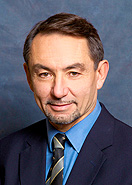Q&A
David Lichter
David G. Lichter, professor of neurology in the School of Medicine and Biomedical Sciences and an expert in movement disorders, including Tourette’s Syndrome and other tic disorders, has been interviewed by numerous local and national media—The Buffalo News, the Today Show and NPR’s “Here and Now,” among others—concerning the emergence of multiple cases of “conversion disorder” in a high school in LeRoy, New York. In the following Q&A, he discusses the disorder and what might be causing it.
What is conversion disorder and why does it seem more common among girls than boys?
Conversion disorder is defined as a loss of, or alteration in, physical functioning in which psychological factors are judged to be causally related to the symptoms. This link is suggested by a temporal relationship between a significant psychosocial stressor and initiation or exacerbation of the symptom. Importantly, the person is not conscious of intentionally producing the symptom. This differentiates conversion disorder from factitious disorder or malingering. Conversion disorder is, indeed, more common among girls than boys and particularly affects adolescent girls and young women. One suggestion is that females are more prone to internalizing stress than males. Females may also be more suggestible than males.
How do you think social networking has influenced the appearance of these symptoms?
In the past, symptoms or behaviors of mass psychogenic illness have been spread from a small number of individuals to larger numbers of individuals by what we call “line of sight” and “line of hearing,” where the affected sufferers share a common, enclosed environment, such as a school. Social networking now provides another avenue for symptoms to be transmitted rapidly to potentially vulnerable individuals who may be geographically distant from or not yet directly exposed to the original cohort.
Do you think the media attention has caused the illness to spread to more people?
It is difficult to know whether media attention may have contributed to the spread of symptoms to others and it is important to note that three of the girls did have pre-existing tic disorders that were not due to psychogenic illness. However, I believe that the intense media scrutiny in this case, including the continued attention to alternative possible causes of the students’ symptoms, has heightened anxiety, fostered an environment of mistrust and diverted attention away from the diagnosis that has been accepted by all professionals who have been directly involved in the evaluation and care of these students, i.e. conversion disorder. The result, in some cases, has been a failure to date to initiate appropriate supportive care or an abandonment of such care. This appears to have resulted in some cases in behavioral regression, compared with symptomatic improvement in those who have accepted the diagnosis and continued with appropriate therapy.
How long does conversion disorder usually last?
In cases where the disorder is quickly diagnosed, the diagnosis is accepted by the family and rapid, appropriate and supportive intervention is undertaken, conversion disorder can be successfully treated, with relatively rapid symptomatic resolution, sometimes in a few weeks. This is particularly likely in cases where the individual has healthy personality characteristics and good family support. In the absence of such positive predictors of outcome, the disorder may become chronic and refractory to treatment efforts.
Are researchers working on ways to better detect and treat conversion disorder?
Researchers are indeed working to better understand and treat conversion disorder. The LeRoy students have been offered free evaluation at the National Institutes of Health and have been offered inclusion in its ongoing research study of conversion disorder, which includes functional brain imaging. This research is being undertaken by the Human Motor Control Section at the National Institute of Neurological Disorders and Stroke by experts in both biologically based and psychologically based movement disorders, including some of the clinical, electrophysiologic and brain imaging overlap between the two.


Reader Comments